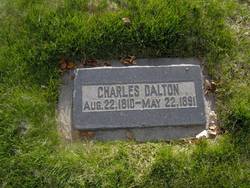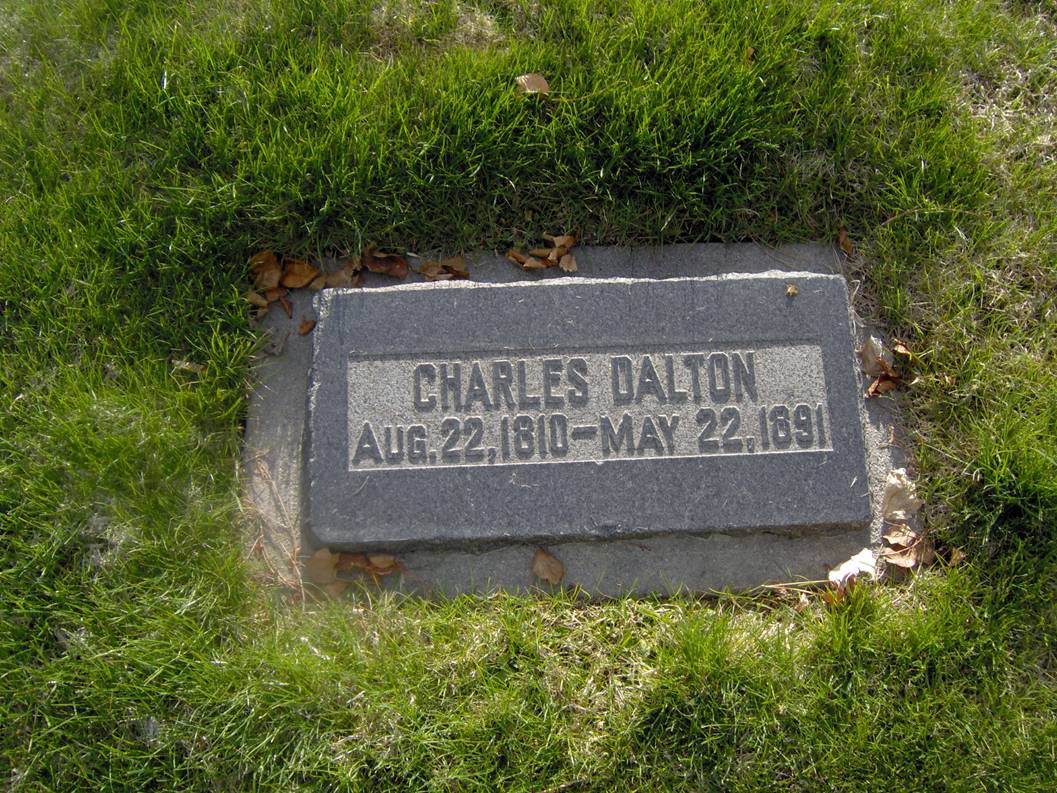Married Mary Elizabeth Warner, 11 Oct 1842
Married Eunice Daniels, 23 Apr 1854, Salt Lake City, Salt Lake, Utah
Married Emily Stevens, 3 Oct 1868, Salt Lake City, Salt Lake, Utah
History - Charles Dalton and Mary Elizabeth Warner were endowed in the Nauvoo Temple on the 10th of January 1846.
In the spring of 1846, they, along with other pioneers, were forced to leave Nauvoo, Illinois, and seek refuge in the unsettled open country of Iowa. Between the Pawnee Station and the Missouri River, Martha Jane was born and died at Winter Quarters only eight months old. Her name is carved on the beautiful monument in the cemetery at Florence, Nebraska.
Charles, 38 years, his wife 22 and only child, John Luther, five years of age, left the Elkhorn River, July 10, 1848, with the Third Division, Willard Richards in charge, and started across the plains for Utah.
The Third Division was composed of 502 whites, 24 negroes, 169 wagons, 50 horses, 20 mules, 515 oxen, 426 cows and loose cattle, 369 shee p, 63 pigs, 5 cats, 170 chickens, 4 turkeys, 7 ducks, 5 doves and 3 goat s. Part of the Division arrived in the Salt Lake Valley on the 19th of October, 1848.
Charles and Mary lived at the Church Farm in Salt Lake City, later moving to Farmington. He was called on a Mission to labor "In the Valleys of the Mountains" on the 7th of October, 1852. "At conference of the Church held in Salt Lake, April 6, 1855, 27 men were called by President Young to go on a mission to the Indians in Idaho and adjacent countries." Charles was one of these missionaries. "Each man was required to take three bushels of wheat, three hundred pounds of flour, and seed suitable for cultivation in the northern climate. The missionaries were instructed to settle among the Flathead, Bannock or Shoshone Indians. They were to raise crops, build houses and forts, and convert the Indians to the ways of civilization, induce them to give up their savage ways, and also to convert them to Mormonism. They left on May 15, 1855. On May 29 they reached Snake River near Fort Hall. In order to cross Snake River they had to repair an old ferry boat. While here three Bannock Indians, who had accompanied the missionaries for several days, applied for baptism. They were the first of about one hundred Bannocks who joined the Church through the efforts of these missionaries."
Charles married Eunice Daniels in Salt Lake City. They lived in Farmington, Centerville, Sugar House, then moved to Peterson in Morgan County. Here he again farmed but also opened a blacksmith shop where the Union Pacific Station now stands. Their home was on a hill about where the school house is located. They were living in Peterson when the first train came through. Farmers exchanged grain, flour and anything they had to pay for "blacksmithing."
Eunice was the mother of six fine sons but died at the age of thirty four. The little wife of John Luther mothered and cared for the little boys until Charles married Emily Halliday, a widow.
They took their eight children and moved to Hooper on March 1, 1870, where Charles farmed and operated another blacksmith shop. It was the most difficult work, as "Hooper was nothing but sagebrush and greasewood." They built their house of boards, straight up and down, with cane squeezings for the roof. Later the house was replaced with one made of adobe.
He was First Assistant Superintendent of Sunday School in South Hooper from 1882 to 1886. He helped organize the first Relief Society in Hooper.
He was a lover of horses as were all his sons and he usually owned a beautiful team.
They lived in South Hooper until the last child was married. They left their old home and lived with William Henry and Simon. Mrs. Dalton spent some time with her son, Steve.
Charles helped his son, John Luther, in genealogy and was chairman of the first Dalton Genealogical Organization.
When Charles was eighty years old he contracted erysipelas and passed away at the home of his son, Simon, in Ogden, Utah. He was buried in the Ogden City Cemetery, Lot 4-6-D, in May, 1891.
Funeral notice of Charles Dalton: Ogden Standard, Sunday May 23 1891. Demise of a Pioneer.
The news of the death of Charles Dalton was received with feelings of sorrow by his many friends yesterday morning. Mr. Dalton was the father of J. L. Dalton, of the firm of Dalton, Nye & Cannon and Simon Dalton of Twenty-third street, at whose residence he passed away. The cause of his demise was old age and general debility. Mr. Dalton was one of the early pioneers of Utah, coming here from Winter quarters in 1848. He left Nauvoo at the time of the exodus. He was a through and respected citizen. The funeral services will be held at the Fourth ward meeting house today, (Sunday) at 2 P.M. All friends are invited to attend, Deseret News please copy.
Mormon Pioneer Overland Travel, Willard Richards Company (1848); Approximate age at departure: 37
Married Mary Elizabeth Warner, 11 Oct 1842
Married Eunice Daniels, 23 Apr 1854, Salt Lake City, Salt Lake, Utah
Married Emily Stevens, 3 Oct 1868, Salt Lake City, Salt Lake, Utah
History - Charles Dalton and Mary Elizabeth Warner were endowed in the Nauvoo Temple on the 10th of January 1846.
In the spring of 1846, they, along with other pioneers, were forced to leave Nauvoo, Illinois, and seek refuge in the unsettled open country of Iowa. Between the Pawnee Station and the Missouri River, Martha Jane was born and died at Winter Quarters only eight months old. Her name is carved on the beautiful monument in the cemetery at Florence, Nebraska.
Charles, 38 years, his wife 22 and only child, John Luther, five years of age, left the Elkhorn River, July 10, 1848, with the Third Division, Willard Richards in charge, and started across the plains for Utah.
The Third Division was composed of 502 whites, 24 negroes, 169 wagons, 50 horses, 20 mules, 515 oxen, 426 cows and loose cattle, 369 shee p, 63 pigs, 5 cats, 170 chickens, 4 turkeys, 7 ducks, 5 doves and 3 goat s. Part of the Division arrived in the Salt Lake Valley on the 19th of October, 1848.
Charles and Mary lived at the Church Farm in Salt Lake City, later moving to Farmington. He was called on a Mission to labor "In the Valleys of the Mountains" on the 7th of October, 1852. "At conference of the Church held in Salt Lake, April 6, 1855, 27 men were called by President Young to go on a mission to the Indians in Idaho and adjacent countries." Charles was one of these missionaries. "Each man was required to take three bushels of wheat, three hundred pounds of flour, and seed suitable for cultivation in the northern climate. The missionaries were instructed to settle among the Flathead, Bannock or Shoshone Indians. They were to raise crops, build houses and forts, and convert the Indians to the ways of civilization, induce them to give up their savage ways, and also to convert them to Mormonism. They left on May 15, 1855. On May 29 they reached Snake River near Fort Hall. In order to cross Snake River they had to repair an old ferry boat. While here three Bannock Indians, who had accompanied the missionaries for several days, applied for baptism. They were the first of about one hundred Bannocks who joined the Church through the efforts of these missionaries."
Charles married Eunice Daniels in Salt Lake City. They lived in Farmington, Centerville, Sugar House, then moved to Peterson in Morgan County. Here he again farmed but also opened a blacksmith shop where the Union Pacific Station now stands. Their home was on a hill about where the school house is located. They were living in Peterson when the first train came through. Farmers exchanged grain, flour and anything they had to pay for "blacksmithing."
Eunice was the mother of six fine sons but died at the age of thirty four. The little wife of John Luther mothered and cared for the little boys until Charles married Emily Halliday, a widow.
They took their eight children and moved to Hooper on March 1, 1870, where Charles farmed and operated another blacksmith shop. It was the most difficult work, as "Hooper was nothing but sagebrush and greasewood." They built their house of boards, straight up and down, with cane squeezings for the roof. Later the house was replaced with one made of adobe.
He was First Assistant Superintendent of Sunday School in South Hooper from 1882 to 1886. He helped organize the first Relief Society in Hooper.
He was a lover of horses as were all his sons and he usually owned a beautiful team.
They lived in South Hooper until the last child was married. They left their old home and lived with William Henry and Simon. Mrs. Dalton spent some time with her son, Steve.
Charles helped his son, John Luther, in genealogy and was chairman of the first Dalton Genealogical Organization.
When Charles was eighty years old he contracted erysipelas and passed away at the home of his son, Simon, in Ogden, Utah. He was buried in the Ogden City Cemetery, Lot 4-6-D, in May, 1891.
Funeral notice of Charles Dalton: Ogden Standard, Sunday May 23 1891. Demise of a Pioneer.
The news of the death of Charles Dalton was received with feelings of sorrow by his many friends yesterday morning. Mr. Dalton was the father of J. L. Dalton, of the firm of Dalton, Nye & Cannon and Simon Dalton of Twenty-third street, at whose residence he passed away. The cause of his demise was old age and general debility. Mr. Dalton was one of the early pioneers of Utah, coming here from Winter quarters in 1848. He left Nauvoo at the time of the exodus. He was a through and respected citizen. The funeral services will be held at the Fourth ward meeting house today, (Sunday) at 2 P.M. All friends are invited to attend, Deseret News please copy.
Mormon Pioneer Overland Travel, Willard Richards Company (1848); Approximate age at departure: 37
Family Members
Advertisement
Records on Ancestry
Sponsored by Ancestry
Advertisement


















